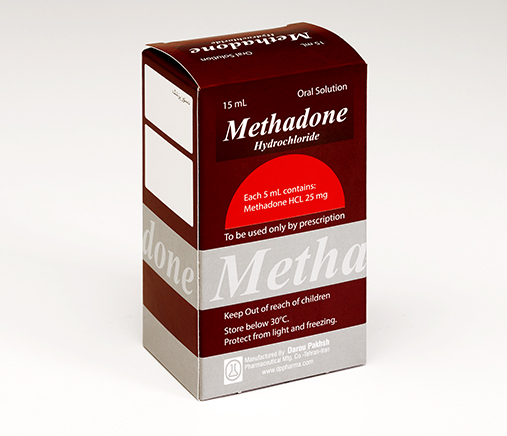Methadone (As Hydrochloride)
- Methadone (As Hydrochloride)
- No Brand Name
- Oral Solution and Suspension
- 25mg/5mL
- Bottle
- 250mL
-
• Pain Management
• Detoxification
• Detoxification
Mechanism of Action
Narcotic agonist-analgesic of opiate receptors, inhibits ascending pain pathways, thus altering perception and response to pain, produces analgesia, respiratory depression, and sedation
Pharmacokinetics
Bioavailability: 36-100%
Onset: 0.5-1 hr
Duration: 4-8 hr
Peak plasma time: 1-7.5 hr
Excretion: Urine
Contraindications
• Hypersensitivity to methadone or formulation components
• Acute abdominal condition, toxin-mediated diarrhea, pseudomembranous colitis
• Concurrent use of Selegiline
• Hypercarbia
• Known or suspected gastrointestinal obstruction, including paralytic ileus
• asthma (acute), significant respiratory impairment, , respiratory depression
• Acute pain or postoperative pain, pain that is mild or not expected to persist
Adverse Reactions
Agitation, Angina pectoris, Anticholinergic effects (dry mouth, palpitation, tachycardia), Bradycardia, Cardiac arrest, Coma, Constipation, Dizziness, Dysphoria, Euphoria, Faintness, Mental clouding or depression, Myocardial infarction, Nausea, Pruritus, urticarial, Nervousness, QT-interval prolongation, Respiratory arrest, Respiratory/circulatory depression, Restlessness, Sedation, Seizures, Severe cardiac arrhythmias, Shock, ST-segment elevation, Sweating, flushing, warmness of face/neck/upper thorax, Syncope, Urinary retention, oliguria, Ventricular tachycardia, Visual disturbances, Vomiting, Weakness
Major Drug Interactions
Alvimopan - Eliglustat - Itraconazole - Ketoconazole - Lefamulin - Levoketoconazole - Olanzapine/Samidorphan - Rasagiline - Ribociclib - Safinamide - Selegiline
Warnings
• Risk of opioid addiction, abuse, and misuse, which can lead to overdose and death
• Assess each patient’s risk prior to prescribing and monitor all patients regularly for the development of these behaviors or conditions
• Serious, life-threatening, or fatal respiratory depression may occur
• Concomitant use of opioids with benzodiazepines or other central nervous system (CNS) depressants, including alcohol, may result in profound sedation, respiratory depression, coma, and death
• QT interval prolongation and serious arrhythmia (torsades de pointes) have occurred during treatment with methadone
• Methadone products, when used for the treatment of opioid addiction in detoxification or maintenance programs, shall be dispensed only by certified opioid treatment programs
Recommendations for Patient
• Accidental of even 1 dose, especially by children, can result in a fatal overdose
• Methadone has a risk for abuse and addiction, which can lead to overdose and death.
• Methadone may also cause severe, possibly fatal, breathing problems and heartbeat problems. To lower your risk, your doctor should have you use the smallest dose of methadone that works, and use it for the shortest possible time.
• Do not increase your dose or use this medication more often than directed.
• Ask your doctor if you should have naloxone available to treat opioid overdose.
• Teach your family or household members about the signs of an opioid overdose and how to treat it.
• The risk for severe breathing problems or heartbeat problems is higher when you start this medication, when you are switching from another opioid to methadone, after a dose increase, or if you use the wrong dose/strength.
• The risk for severe breathing problems or heartbeat problems is higher when you start this medication, when you are switching from another opioid to methadone, after a dose increase, or if you use the wrong dose/strength.
• Most heartbeat problems have happened in people using large doses of methadone for pain relief, but this problem can also occur in people getting smaller doses to treat opioid addiction.
• Using this medication with alcohol or other drugs that can cause drowsiness or breathing problems may cause very serious side effects, including death.
• Get medical help right away if any of these very serious side effects occur: slow/shallow breathing, unusual lightheadedness, severe drowsiness/dizziness, difficulty waking up, fast/irregular heartbeat, fainting.
• Keep this medicine in a safe place to prevent theft, misuse, or abuse.
• During pregnancy, this medication should be used only when clearly needed. It may slightly increase the risk of birth defects if used during the first two months of pregnancy. Also, using it for a long time or in high doses near the expected delivery date may harm the unborn baby.
• Prolonged use during pregnancy can result in neonatal opioid withdrawal syndrome, which may be life-threatening if not recognized and treated.
Pregnancy Considerations
There are no adequate and well-controlled studies in pregnant women.
Breastfeeding Considerations
Methadone present in low levels in human milk. Developmental and health benefits of breastfeeding should be considered along with mother’s clinical need for methadone and any potential adverse effects on the breastfed child from drug or from underlying maternal condition. Advise breastfeeding women taking methadone to monitor the infant for increased drowsiness and breathing difficulties.
Pregnancy Categories
A: Generally acceptable. Controlled studies in pregnant women show no evidence of fetal risk.
B: May be acceptable. Either animal studies show no risk but human studies not available or animal studies showed minor risks and human studies done and showed no risk.
C: Use with caution if benefits outweigh risks. Animal studies show risk and human studies not available or neither animal nor human studies done.
D: Use in LIFE-THREATENING emergencies when no safer drug available. Positive evidence of human fetal risk.
X: Do not use in pregnancy. Risks involved outweigh potential benefits. Safer alternatives exist.
NA: Information not available.

Narcotic agonist-analgesic of opiate receptors, inhibits ascending pain pathways, thus altering perception and response to pain, produces analgesia, respiratory depression, and sedation
Pharmacokinetics
Bioavailability: 36-100%
Onset: 0.5-1 hr
Duration: 4-8 hr
Peak plasma time: 1-7.5 hr
Excretion: Urine
Contraindications
• Hypersensitivity to methadone or formulation components
• Acute abdominal condition, toxin-mediated diarrhea, pseudomembranous colitis
• Concurrent use of Selegiline
• Hypercarbia
• Known or suspected gastrointestinal obstruction, including paralytic ileus
• asthma (acute), significant respiratory impairment, , respiratory depression
• Acute pain or postoperative pain, pain that is mild or not expected to persist
Adverse Reactions
Agitation, Angina pectoris, Anticholinergic effects (dry mouth, palpitation, tachycardia), Bradycardia, Cardiac arrest, Coma, Constipation, Dizziness, Dysphoria, Euphoria, Faintness, Mental clouding or depression, Myocardial infarction, Nausea, Pruritus, urticarial, Nervousness, QT-interval prolongation, Respiratory arrest, Respiratory/circulatory depression, Restlessness, Sedation, Seizures, Severe cardiac arrhythmias, Shock, ST-segment elevation, Sweating, flushing, warmness of face/neck/upper thorax, Syncope, Urinary retention, oliguria, Ventricular tachycardia, Visual disturbances, Vomiting, Weakness
Major Drug Interactions
Alvimopan - Eliglustat - Itraconazole - Ketoconazole - Lefamulin - Levoketoconazole - Olanzapine/Samidorphan - Rasagiline - Ribociclib - Safinamide - Selegiline
Warnings
• Risk of opioid addiction, abuse, and misuse, which can lead to overdose and death
• Assess each patient’s risk prior to prescribing and monitor all patients regularly for the development of these behaviors or conditions
• Serious, life-threatening, or fatal respiratory depression may occur
• Concomitant use of opioids with benzodiazepines or other central nervous system (CNS) depressants, including alcohol, may result in profound sedation, respiratory depression, coma, and death
• QT interval prolongation and serious arrhythmia (torsades de pointes) have occurred during treatment with methadone
• Methadone products, when used for the treatment of opioid addiction in detoxification or maintenance programs, shall be dispensed only by certified opioid treatment programs
Recommendations for Patient
• Accidental of even 1 dose, especially by children, can result in a fatal overdose
• Methadone has a risk for abuse and addiction, which can lead to overdose and death.
• Methadone may also cause severe, possibly fatal, breathing problems and heartbeat problems. To lower your risk, your doctor should have you use the smallest dose of methadone that works, and use it for the shortest possible time.
• Do not increase your dose or use this medication more often than directed.
• Ask your doctor if you should have naloxone available to treat opioid overdose.
• Teach your family or household members about the signs of an opioid overdose and how to treat it.
• The risk for severe breathing problems or heartbeat problems is higher when you start this medication, when you are switching from another opioid to methadone, after a dose increase, or if you use the wrong dose/strength.
• The risk for severe breathing problems or heartbeat problems is higher when you start this medication, when you are switching from another opioid to methadone, after a dose increase, or if you use the wrong dose/strength.
• Most heartbeat problems have happened in people using large doses of methadone for pain relief, but this problem can also occur in people getting smaller doses to treat opioid addiction.
• Using this medication with alcohol or other drugs that can cause drowsiness or breathing problems may cause very serious side effects, including death.
• Get medical help right away if any of these very serious side effects occur: slow/shallow breathing, unusual lightheadedness, severe drowsiness/dizziness, difficulty waking up, fast/irregular heartbeat, fainting.
• Keep this medicine in a safe place to prevent theft, misuse, or abuse.
• During pregnancy, this medication should be used only when clearly needed. It may slightly increase the risk of birth defects if used during the first two months of pregnancy. Also, using it for a long time or in high doses near the expected delivery date may harm the unborn baby.
• Prolonged use during pregnancy can result in neonatal opioid withdrawal syndrome, which may be life-threatening if not recognized and treated.
Pregnancy Considerations
There are no adequate and well-controlled studies in pregnant women.
Breastfeeding Considerations
Methadone present in low levels in human milk. Developmental and health benefits of breastfeeding should be considered along with mother’s clinical need for methadone and any potential adverse effects on the breastfed child from drug or from underlying maternal condition. Advise breastfeeding women taking methadone to monitor the infant for increased drowsiness and breathing difficulties.
Pregnancy Categories
A: Generally acceptable. Controlled studies in pregnant women show no evidence of fetal risk.
B: May be acceptable. Either animal studies show no risk but human studies not available or animal studies showed minor risks and human studies done and showed no risk.
C: Use with caution if benefits outweigh risks. Animal studies show risk and human studies not available or neither animal nor human studies done.
D: Use in LIFE-THREATENING emergencies when no safer drug available. Positive evidence of human fetal risk.
X: Do not use in pregnancy. Risks involved outweigh potential benefits. Safer alternatives exist.
NA: Information not available.
Send to other people




